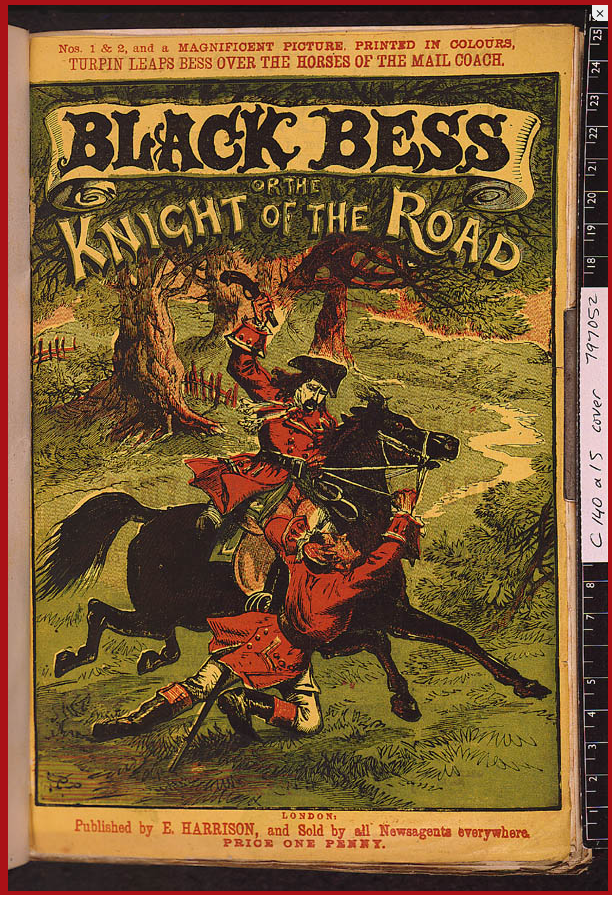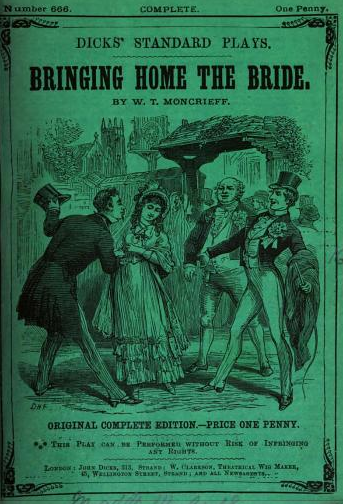|
Ruth The Betrayer
''Ruth the Betrayer; or, The Female Spy'', by Edward Ellis was the first fictional female detective story. It was published as a penny dreadful in 52 parts in 1862-63 by John Dicks, and the British Library's single-volume compilation copy was acquired on 28 February 1863. It therefore predates Andrew Forrester's ''The Female Detective'' and W.S. Hayward's ''The Revelations of a Lady Detective'', both of 1863/4. Ruth Trail, the protagonist, is "a female detective – a sort of spy we use in the hanky-panky way when a man would be too clumsy".Edward Ellis, ''Ruth the Betrayer; or, The Female Spy'' (London, ohn Dicks 1863). The full work has been published in a single volume by Valancourt Books, in 2019, edited and with an introduction by Dagni Bredesen. See also * Barry Ono *List of female detective characters This is a list of fictional female investigators from novels, short stories, radio, television, films and video games. A * Abigail Adams, future first lady, detects ... [...More Info...] [...Related Items...] OR: [Wikipedia] [Google] [Baidu] |
Penny Dreadful
Penny dreadfuls were cheap popular serial literature produced during the nineteenth century in the United Kingdom. The pejorative term is roughly interchangeable with penny horrible, penny awful, and penny blood. The term typically referred to a story published in weekly parts of 8 to 16 pages, each costing one penny. The subject matter of these stories was typically sensational, focusing on the exploits of detectives, criminals, or supernatural entities. First published in the 1830s, penny dreadfuls featured characters such as Sweeney Todd, Dick Turpin, Varney the Vampire, and Spring-heeled Jack. The BBC called penny dreadfuls "a 19th-century British publishing phenomenon". By the 1850s, there were up to a hundred publishers of penny-fiction, and in the 1860s and 1870s more than a million boys' periodicals were sold a week. ''The Guardian'' described penny dreadfuls as "Britain's first taste of mass-produced popular culture for the young", and "the Victorian equivalent o ... [...More Info...] [...Related Items...] OR: [Wikipedia] [Google] [Baidu] |
John Dicks (publisher)
John Thomas Dicks (1818–1881) was a publisher in London in the 19th century. He issued popular, affordably priced fiction and drama, such as "shilling Shakespeares and wonderfully cheap reprints of Walter Scott, Scott and other standard authors." Earlier in his career he worked with Peter Perring Thoms and George W. M. Reynolds. Employees included illustrator Frederick Gilbert. Readers included Thomas Burt and Havelock Ellis. Dicks retired in the 1870s, when his sons took over the firm which continued into the 1960s. Works issued by John Dicks * (sheet music series)numbered list Drama * * (series) Dicks' Standard Plays * (series) * – arranged by number, title, author (Ainsworth, Dickens, Lytton, Scott, etc.), and theme (nautical, dumb hero, ghost, Irish, Scotch, military, temperance, fairy, equestrian, etc.) Fiction * * (series); [...More Info...] [...Related Items...] OR: [Wikipedia] [Google] [Baidu] |
James Redding Ware
James Redding Ware (1832 c. 1909, pseudonym Andrew Forrester) was a British writer, novelist and playwright, creator of one of the first female detectives in fiction. His last known work was a dictionary. Early life James Redding Ware was born in Southwark, South London, in 1832, the son of James Ware, a grocer, and Elizabeth, née Redding. By 1851, his father had died, and his mother, according to the census, was a grocer and tea-dealer, and James Redding Ware was her assistant. By 1861, the household was no longer in place, and J. R. Ware was not readily identifiable in the census. But in 1865, James Redding Ware became a Freemason, at the Westbourne Lodge No. 733, and he was living in Peckham. He became a Junior Warden at the Urban Lodge, no. 1196, and by 1872 a Worshipful Master (WM). Literary career His detective works include: ''The Female Detective'' (c. 1863/1864), 'edited by A.F.'; ''Secret Service, or, Recollections of a City Detective'' (1864?); ''The Private Det ... [...More Info...] [...Related Items...] OR: [Wikipedia] [Google] [Baidu] |
Barry Ono
Barry Ono (1876–1941) was a British variety theatre performer, collector of penny dreadfuls and benefactor of the British Library. His collection of songbooks was bequeathed to the British Library in 1941. Life Barry Ono was the stage name of Frederick Valentine Harrison. Ono was born in Chelsea, London on 21 May 1876. Though he struggled early in his career as a comedian and comedic songwriter, he did gain some notoriety and experienced a peak in his career in 1929. Several of his songs were published in collections such as The Great Barry Ono Song Book.A second edition of The Great Barry Ono Song Book is held by the British Library. The book contains several original songs by Ono and references others not mentioned in the book. Many of the songs have as their themes military or international topics. On the front page is a blurb explaining that Barry Ono claimed "to be the First Artiste in the World to SING a Song of orld War I and the First Author to Write one" because ... [...More Info...] [...Related Items...] OR: [Wikipedia] [Google] [Baidu] |
List Of Female Detective Characters
This is a list of fictional female investigators from novels, short stories, radio, television, films and video games. A * Abigail Adams, future first lady, detects in 1770s Massachusetts in a series by Barbara Hambly (as Barbara Hamilton) began in 2009. * Hilda Adams is a nurse who takes jobs to investigate, in series by Mary Roberts Rinehart, begun in 1914 with '' The Buckled Bag''; played by Joan Blondell in a Warner Bros. film, ''Miss Pinkerton'' (1932). Rinehart then adopted this movie nickname for use in her Adams stories. * Portia Constance Adams is a Canadian amateur detective who mysteriously inherits the 221B Baker Street townhouse in 1930 in a book series by Canadian Angela Misri launched 2014. * Riley Adams CSI: Crime Scene Investigation * Laura Ackroyd is an investigative reporter who solves crimes in West Yorkshire with her boyfriend DCI Michael Thackery in a book series begun by Patricia Hall (Maureen O’Connor) in 1994. * Irene Adler is an opera singer in t ... [...More Info...] [...Related Items...] OR: [Wikipedia] [Google] [Baidu] |
Fictional British Police Detectives
Fiction is any creative work, chiefly any narrative work, portraying individuals, events, or places that are imaginary, or in ways that are imaginary. Fictional portrayals are thus inconsistent with history, fact, or plausibility. In a traditional narrow sense, "fiction" refers to written narratives in prose often referring specifically to novels, novellas, and short stories. More broadly, however, fiction encompasses imaginary narratives expressed in any medium, including not just writings but also live theatrical performances, films, television programs, radio dramas, comics, role-playing games, and video games. Definition Typically, the fictionality of a work is publicly marketed and so the audience expects the work to deviate in some ways from the real world rather than presenting, for instance, only factually accurate portrayals or characters who are actual people. Because fiction is generally understood to not fully adhere to the real world, the themes and con ... [...More Info...] [...Related Items...] OR: [Wikipedia] [Google] [Baidu] |
Fictional English People
Fiction is any creative work, chiefly any narrative work, portraying individuals, events, or places that are imaginary, or in ways that are imaginary. Fictional portrayals are thus inconsistent with history, fact, or plausibility. In a traditional narrow sense, "fiction" refers to written narratives in prose often referring specifically to novels, novellas, and short stories. More broadly, however, fiction encompasses imaginary narratives expressed in any medium, including not just writings but also live theatrical performances, films, television programs, radio dramas, comics, role-playing games, and video games. Definition Typically, the fictionality of a work is publicly marketed and so the audience expects the work to deviate in some ways from the real world rather than presenting, for instance, only factually accurate portrayals or characters who are actual people. Because fiction is generally understood to not fully adhere to the real world, the themes and cont ... [...More Info...] [...Related Items...] OR: [Wikipedia] [Google] [Baidu] |
Literary Characters Introduced In 1862
Literature is any collection of written work, but it is also used more narrowly for writings specifically considered to be an art form, especially prose fiction, drama, and poetry. In recent centuries, the definition has expanded to include oral literature, much of which has been transcribed. Literature is a method of recording, preserving, and transmitting knowledge and entertainment, and can also have a social, psychological, spiritual, or political role. Literature, as an art form, can also include works in various non-fiction genres, such as biography, diaries, memoir, letters, and the essay. Within its broad definition, literature includes non-fictional books, articles or other printed information on a particular subject.''OED'' Etymologically, the term derives from Latin ''literatura/litteratura'' "learning, a writing, grammar," originally "writing formed with letters," from ''litera/littera'' "letter". In spite of this, the term has also been applied to spoken or ... [...More Info...] [...Related Items...] OR: [Wikipedia] [Google] [Baidu] |




